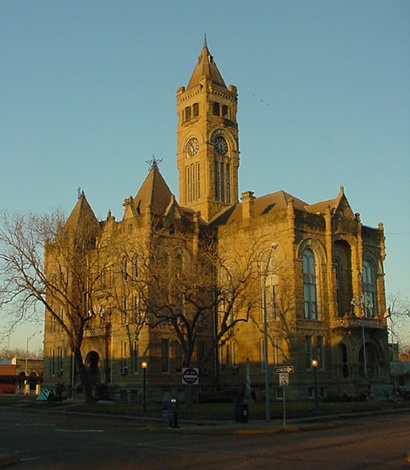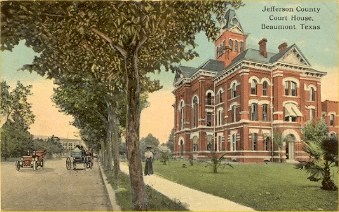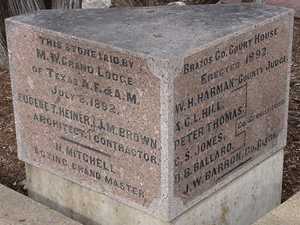Architect Eugene Heiner, his Texas Courthouses, jails, and notable buildings. (original) (raw)

Portrait of Eugene T. Heiner
Photo courtesy Nesbitt Memorial Library, Columbus, Texas
A New Yorker by birth, Eugene T. Heiner came into the world on August 20, 1852 in NYC. At the tender age of thirteen, he was apprenticed to a Chicago architect. He moved to Dallas in 1877, and arrived in Houston in 1878. Houston was where he would spend the rest of his short (but prolific) life.
See Eugene Thomas Heiner - Historical Marker
In the late 1880s Heiner designed several buildings at Texas A & M University at College Station as well as the Brazos County Courthouse in nearby Bryan. One building at the Texas State Penitentiary in Huntsville was designed by Heiner and several commercial buildings in Galveston. The bulk of his work was close to home in Harris County. Heiner occasionally designed private houses - including the home of Charles S. House and that of Thomas H. Scanlan.
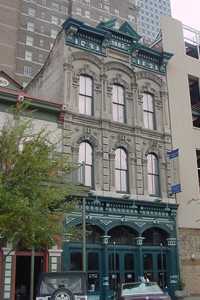
The Henry Brashear Building (1882), a Heiner building in downtown Houston at 910 Prairie Avenue
TE photo 2-2005
Cotton Exchange, Houston, 1884
W. L. Foley Building, Houston 1889
Henry Brashear Building 1882
W. House Bank, Houston 1889
Houston High School, 1894
Houston Ice and Brewing Company, 1893*
Sweeney and Coombs Opera House, Houston 1890
An Incomplete List of Heiner Courthouses:
Austin County Courthouse, Bellville, 1888 (burned 1960)
Brazoria County Courthouse, Angleton, 1897 (now a library)
Brazos County Courthouse, Bryan, 1892 (razed)
Colorado County Courthouse, Columbus, 1891
Falls County Courthouse, Marlin, 1888 (razed)
Jasper County Courthouse, Jasper (Altered)
Jefferson County Courthouse, Beaumont, 1893 (razed)
Lavaca County Courthouse, Hallettsville, 1897
Matagorda County 1895 Courthouse, Bay City (razed)
Polk County 1884 Courthouse, Livingston (razed)
Runnels County Courhouse, Ballinger 1889 (Altered)
Wharton County Courthouse, Wharton, 1889 (restored 2005-2006)
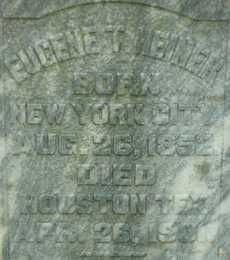
Eugene T. Heiner was a founding member of the Texas State Association of Architects in 1886. He died in Houston on April 26, 1901 and is buried in Houston's Glenwood Cemetery - within sight of downtown Houston. A historical marker has recently been erected over his grave.
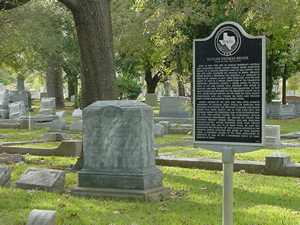
The Heiner Gravesite and historical marker
2525 Washington Ave.
Glenwood Cemetery, Section C4
TE photo, 2005
Historical Marker Text
Eugene Thomas Heiner
(August 20, 1852 - April 26, 1901)
Born in New York City to German immigrants Nicholas and Margaretta Heiner, Eugene Thomas Heiner apprenticed himself to a Chicago architect when he was thirteen years old and later completed his training in Berlin, Germany. Heiner became a draftsman for architect J. A. Vrydaugh in Terre Haute, Indiana, in 1873. Three years later, with the prize money he won in a design competition at the Philadelphia Centennial Exposition, Eugene T. Heiner moved to Dallas. There he met and married Viola Isenhour. They settled in Houston and were the parents of four daughters. His first major design was rendered for the Galveston County Jail in 1878. Heiner became known for his work on Texas county courthouses and jails, though his work also included many commercial buildings and private homes.
Heiner's designs of the 1870s and 1880s often employed variations of Classical detail typical of American High Victorian architecture. The two-story Italianate and Second Empire style Smith County Jail in Tyler (1880-1881) was designed during the prosperous days after Reconstruction. His style then shifted toward the increasingly popular Richardsonian Romanesque, but retained his strong High Victorian tendency toward vertical lines and structural ornamentation. Heiner designed more than twenty courthouses and jails in as many years. He also was responsible for the design of such unusual buildings as the Houston Cotton Exchange and Board Of Trade Building (1884). A founding member of the Texas Association Of Architects in 1886, he left a remarkable legacy of public buildings in Texas.
